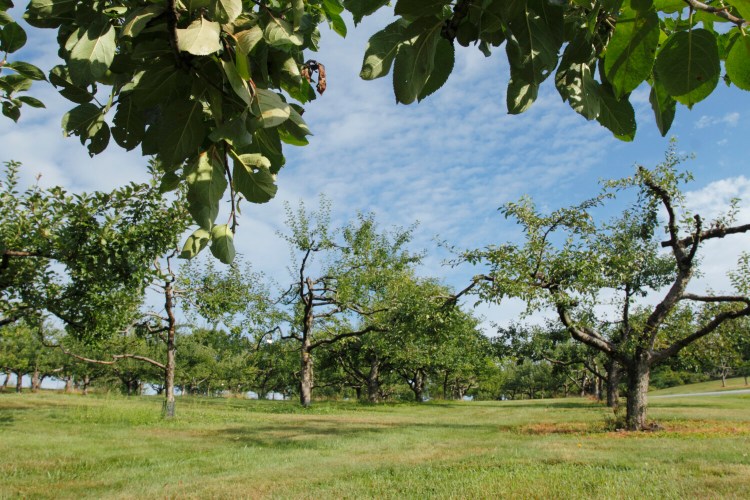When I read in the Fedco Trees catalog last winter that the company was working with Tower Hill Botanic Gardens to replace all of the 119 apple trees in the garden’s orchard, I was intrigued.
Tower Hill is in Boylston, Massachusetts, but my wife, Nancy, has a connection to it. Her late uncle, Richard Dearborn, was a trustee of the Worcester Horticultural Society and helped lead the effort to create Tower Hill and its historic orchard in the late 1970s and 1980s.
When I called about the Tower Hill project, Fedco put me in touch with John Bunker, the company’s longtime apple guru – even though Bunker insists he is retired.
Bunker was mesmerized when he first saw the Tower Hill orchard because it was laid out in gardens along the entrance road, so that every visitor to the botanical garden gets to see it. “It was the most beautifully laid out of any orchard I had ever seen,” he said. “They did a fantastic job.”

A Lady Apple tree grows at Tower Hill Botanic Garden’s orchard. Photo by Mary Kocol/ Courtesy of the Tower Hill Botanic Garden
But because the apples were grafted onto dwarf and semi-dwarf root stocks common at the time, and those trees have shorter lifespans, the orchard was threatened by disease.
All of the apples in the orchard were historic New England species, and 30 to 40 of them were exceedingly rare. Given that, Bunker approached the staff at Tower Hill about rescuing them.
A little background here, all of which I got from “Apples and the Art of Detection,” which Bunker wrote, illustrated and, in 2019, self-published. Apple trees that grow from seeds, called seedling trees, will not be duplicates of the parent. For that reason, all named apple varieties are grafted.
To graft an apple, a living twig – called a scion – must be cut from the tree that the orchardist wants to replicate. Even if the tree is almost dead, and has just one barely alive twig, a graft is possible. That scion is then attached to another apple tree, the root stock. To do so, the gardener first makes a cut in the root stock and then uses tape, wax or another method to hold the scion in place until it’s able to make a living connection to the root stock. The new apple tree is then grown in a nursery for two or more years before it is planted.
In January 2019, Bunker and his wife, Cammy Watts, went to Tower Hill and took scions from all 119 of Tower Hill’s apple trees. Then, because Bunker is retired, Fedco’s tree grafters created at least two trees for each variety, one on a standard and the other on a new, improved semi-dwarf root stock. “I did some grafting myself on some of the really rare ones,” Bunker said, as a sort of insurance policy.

New saplings grow at Fedco from the Tower Hill Botanic Gardens’ Davenport Collection of pre-20th century heirloom varieties. Photo by Mark Richardson/courtesy of Tower Hill Botanic Gardens
For two years, the trees grew at the Fedco nursery, during which time the original trees at Tower Hill were removed, because they were diseased. Now, the orchard is replanting with the new grafted trees, according to an email from Mark Richardson, Tower Hill’s director of horticulture and Bunker’s collaborator on the project. The rare April blizzard delayed the planting a bit, he wrote. By the time you read these words, though, it’ll probably be done.
“We are planting at least two of every variety, but on two different semi-dwarf rootstocks,” Richardson wrote. “We have about 30 on standard rootstocks that will line the driveway as you enter the garden.”

Heirloom apple scions were grafted onto new root stock; in April, the resulting saplings were planted at the botanical garden. Fedco and apple expert John Bunker helped restore the orchard, all 119 trees. Photo by Robert Burgess/courtesy of Tower Hill Botanic Garden
The trees should begin bearing fruit in two or three years, and I will make sure to take a trip to Tower Hill to see them then. Before then, though, I will take a trip to Unity (maybe during the Common Ground Fair) to see the Maine Heritage Orchard on the Maine Organic Farmers and Gardeners Association property. That orchard has more than 300 varieties of apple trees, from all over Maine.
The Tower Hill orchard includes Red Astrachan, an apple that Stella Dearborn, Nancy’s grandmother and Richard’s mother, always said was her favorite apple, especially for pies. Bunker also has high praise for Red Astrachan in his book.
Unfortunately, by the time I joined the family, the Red Astrachan tree had died, and I never got to taste her pie with that apple – although I enjoyed many of her pies made with other apples.
There is an old joke that the best time to plant a tree was 20 years ago, and the second best time is now. I should have planted a Red Astrachan when Stella praised it 40 years ago. I will plant it on our property next spring. I’d plant it now, but Fedco has stopped taking orders this year, and the other online nurseries I checked were out of Red Astrachan.
Tom Atwell is a freelance writer gardening in Cape Elizabeth. He can be contacted at: tomatwell@me.com.
Send questions/comments to the editors.



Comments are no longer available on this story